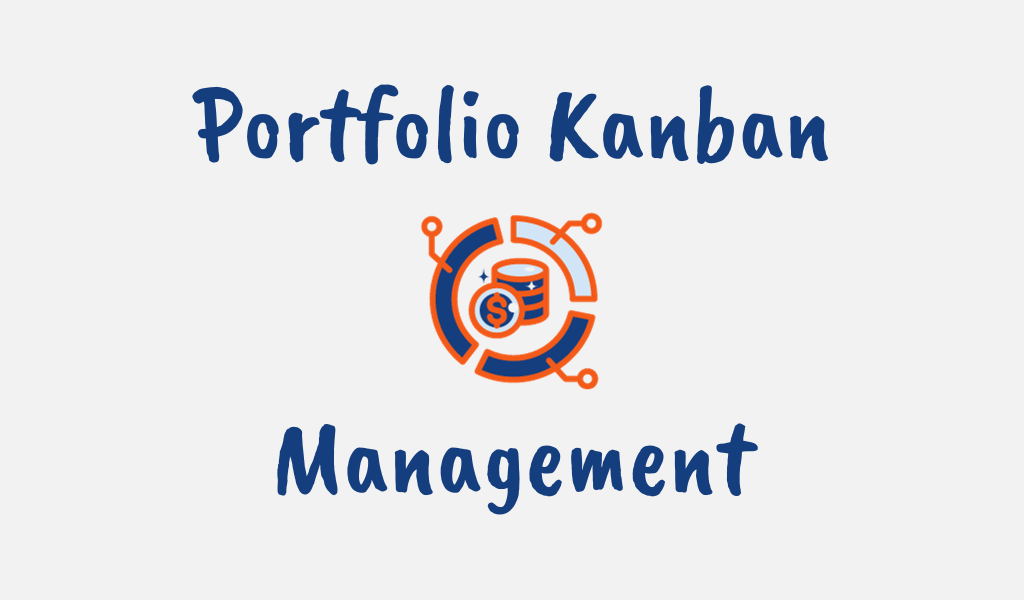When adopting the SAFe framework, implementing an effective portfolio Kanban system is key to managing strategic initiatives and epics as it provides a streamlined system for visualizing the flow of value through the enterprise’s portfolio.
Operating under Lean Portfolio Management (LPM), it facilitates continuous flow and matching of demand to available capacity.
The portfolio Kanban contains states such as funnel, reviewing, analyzing, and implementing to manage each epic from ideation to completion.
This post provides an overview of the SAFe portfolio Kanban system and its role in helping enterprises align strategy with execution, its structure, major Kanban states, who is responsible for managing the portfolio Kanban, and key benefits.
What is Portfolio Kanban in SAFe?
The portfolio Kanban is a visual management method used in the SAFe framework to manage the flow of portfolio epics from ideation through implementation.
It is one of several built-in Kanban systems in SAFe, including team Kanban, program Kanban, and solution Kanban.
Specifically, the portfolio Kanban helps Lean portfolio management teams visualize, analyze, and manage the flow of the largest and most strategic initiatives and epics across the SAFe portfolio.
It provides transparency into the epic workflow and highlights bottlenecks to address as epics flow through the system.
The portfolio Kanban system in SAFe has a few key aspects:
- It is used to align strategy with execution by managing the flow of strategic epics
- It matches demand to available capacity through work-in-progress (WIP) limits
- It contains Kanban states such as funnel, reviewing, analyzing, implementing, and done to manage each epic from ideation to completion
- The movement of epics is governed by policies and facilitated by epic owners
- It provides visibility into flow and opportunities for improvement
Overall, the SAFe portfolio Kanban gives enterprises a streamlined system to manage strategic initiatives across the portfolio and continuously improve flow. Its implementation is critical for organizations adopting SAFe to scale Agile.

Structure of the Portfolio Kanban System
The portfolio Kanban system in SAFe contains a set of standard states that each epic flows through, from creation to completion.
Let’s look at each of these Kanban states in more detail:
Funnel
The funnel is the initial state in the portfolio Kanban system. All new epic ideas and initiatives enter the funnel, which acts as a holding area.
The funnel captures strategic ideas from various sources, including the portfolio vision, continuous exploration, teams, and stakeholders.
Epic ideas that enter the funnel are described with a high-level phrase or title. There are no work-in-progress (WIP) limits on the funnel, as it simply captures ideas for consideration.
Ideas here may be large enough to exceed the epic threshold or have strategic implications.
Reviewing
Once capacity becomes available, an epic owner pulls the epic into the reviewing state to further define and analyze it.
In reviewing, the epic owner works with stakeholders to create the epic hypothesis statement, which includes:
- Epic description
- Business outcomes hypothesis
- Leading indicators
- Non-functional requirements
Initial sizing, cost estimates, and WSJF ranking also occur here. WIP limits can control the number of epics in reviewing.
The epic owner presents the epic at portfolio Kanban events for consideration to move into analyzing.
Analyzing
Promising epics from reviewing enter the analyzing state for further analysis and vetting. In analyzing, activities include:
- Evaluating solution options
- Defining the minimum viable product (MVP)
- Creating the lean business case
- Conducting research spikes and customer validation
The WIP limit keeps the number of epics here small. The lean portfolio management team reviews the business case and makes a “go/no-go” decision via the portfolio Kanban.
Portfolio Backlog
Once approved from analyzing, the epic moves into the Portfolio Backlog. This acts as a holding state for upcoming epics based on priority.
LPM periodically reviews backlogged epics and re-prioritizes them as needed.
Implementing: MVP
The highest priority epic flows from the Portfolio Backlog into the Implementing: MVP state.
Here, the epic owner works with agile teams to build the MVP and test the epic’s hypothesis.
Teams build MVP features until the allocated budget is spent or the hypothesis is proven or disproven.
Implementing: Persevere
If the MVP proves the hypothesis, the epic proceeds to Implementing: Persevere. Agile teams continue building out the full epic vision in this state, managing scope via ongoing prioritization.
The epic stays here until WSJF indicates other priorities, and LPM agrees its portfolio oversight is no longer needed
Done
The done state represents the end stage of an epic in the portfolio Kanban. An epic enters this state when Lean Portfolio Management decides the epic no longer requires active portfolio oversight.
Criteria for marking an epic as done include:
• The epic is ejected from the portfolio Kanban earlier in the workflow
• The MVP disproves the initial hypothesis
• The hypothesis is proven, and the epic delivers sufficient value
In the last case, ARTs may continue working on the epic, but it is no longer governed at the portfolio level. Epic owners may retain some responsibilities, but leading indicators and KPIs drive ongoing work.
Reaching done signifies the epic has delivered its expected strategic value and portfolio leaders can shift focus to new priorities.

Who is Responsible for Managing the Portfolio Kanban?
The epic owners play a key role in managing epics through the portfolio Kanban system.
As epics flow through the portfolio Kanban states, the epic owner facilitates progression by pulling the epic into the next logical state when capacity allows.
The epic owner does not work alone, but rather collaborates closely with other stakeholders throughout the process, including:
- Business Owners: Help define epic goals and outcomes
- Architects/Engineers: Provide technical guidance and support
- Product Management: Give product direction and prioritization
- Agile Teams: Build and deliver epic features
Together, they help analyze the epic, create the viable product and lean business case, implement features, and determine when the epic is complete.
The portfolio Kanban system is overseen at the enterprise level by Lean Portfolio Management. LPM has the authority and visibility to review and approve epic workflow through the system.
During portfolio Kanban events like the portfolio sync and strategic portfolio review, LPM assesses epic status, monitors flow, adjusts WIP limits, and makes go/no-go decisions.
LPM also continuously improves the system itself by analyzing metrics and adjusting policies.

Benefits of the Portfolio Kanban System
Implementing a portfolio Kanban system provides several benefits:
1. Workflow Visualization
The Kanban board provides complete transparency into the end-to-end epic workflow across the portfolio.
All stakeholders can visually see the epic status and quickly identify bottlenecks or flow issues which enables data-driven improvements.
2. Focus on Flow
WIP limits force focus on finishing work rather than starting new epics. The structured Kanban states also promote flow by preventing epics from getting stuck in nebulous “in-progress” statuses.
Together, these practices reduce multitasking and ensure epics get fully completed.
3. Continuous Improvement
The flow metrics generated, like cycle time and throughput, highlight areas where policies or changes can improve flow. The portfolio Kanban facilitates fact-based, incremental improvement over time.
4. Aligned Strategy
Lean Portfolio Management can ensure epics align with strategic objectives and adjust course as needed.
The portfolio Kanban gives executives visibility to guide strategy based on real-time status.
5. Objective Decision-making
Lean business cases, WSJF prioritization, and defined exit criteria enable more objective data-driven decisions on epics reducing opinions and emotions.
6. Governance and Compliance
Standard portfolio Kanban policies provide necessary guardrails for governance, risk management, regulatory compliance, and other enterprise concerns.
7. Improve Forecasting
The historical flow metrics generated allow more accurate forecasting for capacity planning, budgeting, and ROI projections.
Difference between Portfolio Kanban and Team Kanban
While portfolio Kanban and team Kanban are both Kanban systems that provide the visibility needed to align strategy with on-the-ground execution, they differ in some key ways:
- Strategic vs. Tactical: Portfolio Kanban manages strategic epics, while team Kanban focuses on tactical team backlogs and workflows.
- Flow Unit: The flow unit for portfolio Kanban is the epic. For team Kanban, it is typically user stories or development tasks.
- Scope: Portfolio Kanban spans multiple teams and value streams. Team Kanban is used within a single team.
- WIP Limits: Since epics are larger, portfolio Kanban WIP limits are wider. Team Kanban WIP limits are narrower.
- Frequency: Portfolio Kanban events like portfolio syncs occur frequently but less often than daily standups.
- Metrics: Portfolio Kanban focuses on epic flow and financial metrics. Team Kanban uses Sprint burndown and flow efficiency metrics.
- Decisions: Portfolio Kanban decisions consider strategy alignment and ROI. Team Kanban optimizes for throughput and predictability.
Conclusion
Implementing an effective portfolio Kanban system is foundational for organizations adopting the SAFe framework.
The portfolio Kanban provides the visibility and workflow needed to manage strategic epics across the enterprise portfolio.
While it takes work to design and implement, the payoff is immense. The portfolio Kanban gives executives the insights needed to guide strategy while empowering teams to deliver maximum business value.





